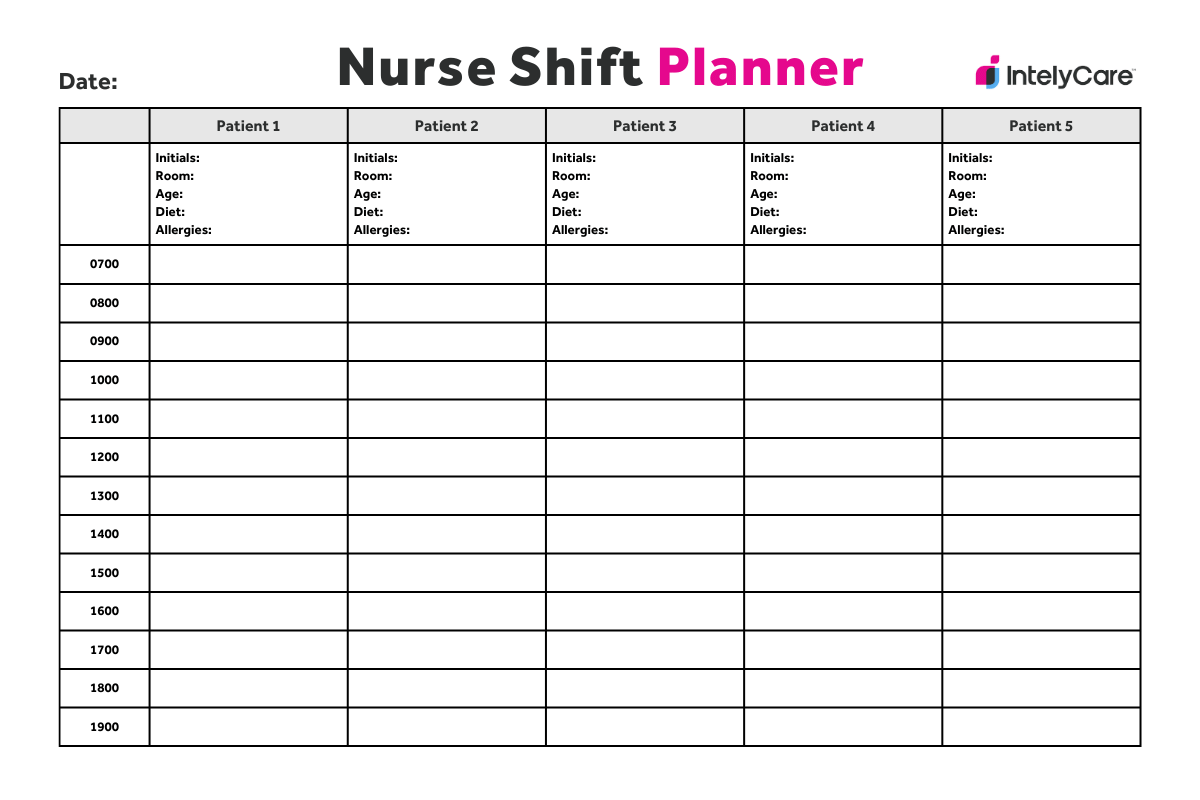Setting Up an Hourly Nursing Shift Planner: 5 Tips

Healthcare facilities put thoughtful investment into the technology that improves nursing workflows. Whether they’re scanning meds or reviewing labs at the bedside, nurses have access to critical patient data in an instant. But even with state-of-the-art technology at their fingertips, there’s one resource a nurse can’t live without: their brain.
No, we don’t mean the organ floating beneath the skull. The nurse’s “brain” also known as an hourly nursing shift planner, is what keeps them on track throughout a shift. If you’ve ever encountered a nurse who’s lost their “brain” you know the sheer panic (and deployment of a search party) its absence causes. Here’s how to support nurses in your facility by providing a simple resource that keeps them organized and sane.
Managing Workloads and Distractions
Every nurse has their own way of managing a patient workload. Two resources to keep organized from the start of a shift are a handoff report sheet and an hourly nursing shift planner. Both are physical items where a nurse can write down pertinent patient information to reference throughout the shift. A report sheet includes a thorough history from the off-going to the on-coming nurse. A shift planner gives the nurse a place to plan out tasks for the shift.
Having physical reference sheets comes in handy when distractions arise — which is unsurprisingly common in nursing. According to a literature review of over 20 studies on healthcare distractions, nurses encounter up to 13 interruptions per hour. They come from all directions, with the most common distractions coming from patients, families, and staff. Equipment failure and lack of supplies are not far behind.
Distractions in healthcare compromise patient safety. When a nurse loses concentration during a task, they’re more likely to:
- Make mistakes.
- Delay care.
- Leave tasks incomplete.
- Have a change in clinical decision-making.
How to Set Up a Nursing Shift Planner: Step-by-Step
Shift planners help nurses get centered when their concentration is disrupted. This simple resource can be a part of a bigger ecosystem of safety measures that improve quality of care. If you’re considering providing this resource to nurses in your facility, follow these steps to build yours out.
1. Start With a Basic Grid
Nurses use their shift planner to map out tasks for the shift. Create a grid that makes space for each patient on the horizontal axis and each hour of the shift along the vertical axis.
Example for a five-patient assignment:
Tip: It’s important to use military time so there’s no confusion about AM or PM timing (such as when a medication is due or when a test needs to be run). Make a separate hourly nursing shift planner for the night shift that runs from 1900-0700.
2. Include Space for Patient Info
Leave room for identifying patient info along the horizontal axis. Some nurses may choose to place a patient label here, which includes identifying data like their medical record number. Another idea is to include a banner with space for identifiers like:
- Room number
- Patient’s name
- Age
- Weight
- Admitting diagnosis
- Allergies
- Code status
- Isolation precautions
Tip: Consider the scenario of a nurse who’s in the middle of a task, gets called to another patient’s room, and resumes the original task. During the moment of asking “Where was I?” the nurse could easily glance down and recall they were headed to bed 15, the postop hip replacement patient from yesterday.
3. Leave Extra Space for Busy Hours
Are 0900 and 2100 the busiest times for passing meds on your unit? If so, leave extra space in those hour blocks. Many nurses prefer to write out every medication — even if there are many — so they know what to pull in the med room.
Take into account other potentially task-heavy hours, leaving room for items like:
- AM labs or chest X-rays
- Order changes during rounds
- Tube feedings
- Oral care
- Q2 turns
- Central line care, such as dressing or tubing changes
- Orders to be addressed on evening rounds
4. Customize the Sheet Based on the Unit
Allow the shift planner to reflect the nature of the nursing unit. For example, a nurse’s task list in a skilled nursing facility will look different than in critical care. For units with higher-volume patient assignments, you’ll need to create more room on the horizontal axis. In the ICU, nurses may prefer to use separate sheets for each patient.
5. Keep it Simple
Nurses have enough to look forward to at the beginning of a shift, so there’s no need to over-complicate hourly nursing shift planners. Having a blank canvas can reduce the overwhelming nature of a healthcare environment and give nurses a sense of empowerment. If you’d like to include reminders (such as infection prevention protocols, restraints, etc.), place a brief checklist at the bottom of the page.
Find More Ways to Optimize the Nursing Workflow at Your Facility
Improving nursing workflow doesn’t always have to come with a hefty price tag. An hourly nursing shift planner is a cheap and easy resource that can help make nurses’ shifts a little smoother. Discover more practical workflow tools and tips that ease the burden of managing a facility, through InteylCare’s free newsletter.

